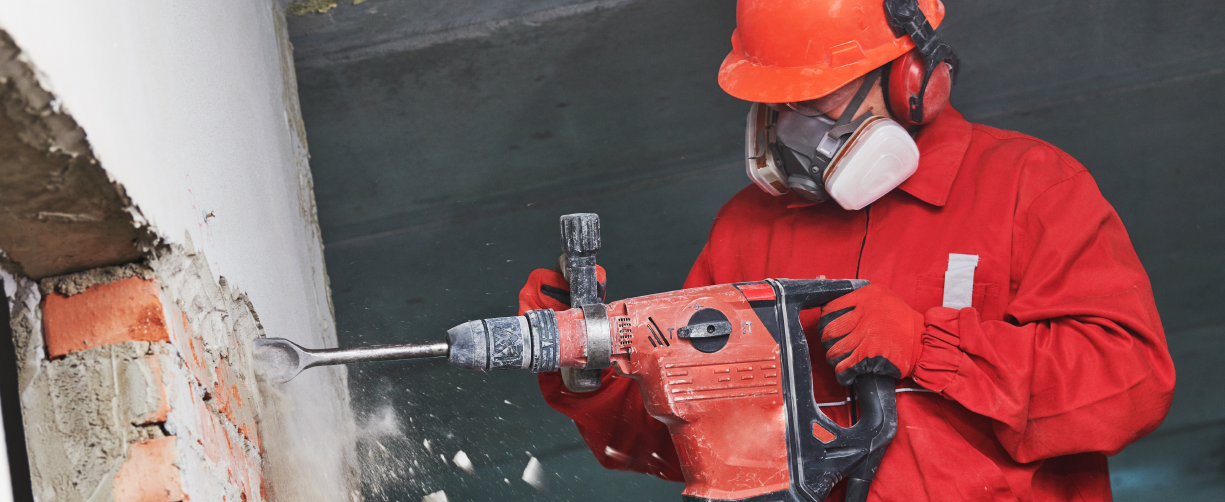Demolition works as a part of the construction project

Demolition means to demolish or dismantle part or a whole piece of structure related to the physical integrity of the constructed structure. A structure includes buildings, sheds, towers, storage, silos, etc.- both fixed and moveable. The Health and Safety Executive states all demolition, dismantling and structural alteration must be carefully planned and carried out in a way that prevents danger by practitioners with the relevant skills, knowledge and experience.(source: HSE)
All relevant information, laws and guidance for the demolition can be obtained from for instance:
- Construction (Design and Management) Regulations 2015 (CDM 2015)
- Control of substances hazardous to health (COSHH) 2002
- Party Wall Act 1996
- Health and Safety Executive website and publications
- National Federation of Demolition Contractors
Demolition projects or works are considered high risk and should be based on the collaborative approach of all parties involved in the construction project- clients, designers, contractors, subcontractors and site managers. Health and Safety duties related to the demolition works are mainly on the primary contractor, so Construction Phase Plan and Health and Safety Policy is required after all Pre-construction Information are obtained from the client.
The Pre-demolition phase
Demolition requires six weeks prior notice to the Local Authority Building Control prior to works commencement. Building control surveyors inspect the site before demolition stage to ensure the health and safety policy is in place and to impose the control measures, or establish if there will be any remedial works needed on adjoining buildings or what will be the effect on services and the treatment of the site on completion. Anyone who needs to undertake demolition works has to notify the local building control inspectors with formal notice, unless the structure is considered exempt from notice requirement. The notice should describe the building, the demolition work, and client name and address. There is a need to supply copies of the Method Statement for the demolition work and Asbestos Type 3 Survey Report. Such notice has to be also given to the occupier of any adjacent building, utility suppliers, Health and Safety Executive, Environment Agency, police and fire service. Moreover, any alteration of a listed building requires a separate formal listed building consent and planning permission. Demolition work must also comply with the Construction (Design and Management) Regulations 2015 and a health and safety plan has to be produced by the principal contractor.
When giving approval for demolition work to take place, the Council will require the owner and contractor to adhere to certain conditions, these include:
-Adequate shoring, repair and weatherproofing of adjacent buildings
-Plan for waste removal
-The disconnection of utilities
-Asbestos control
-Noise control
The demolition stage
Demolition is the most high-risk construction work. Taking into account all the key information about the particular project the demolition plan should be prepared to enable safe and efficient works.
There is the range of demolition methods that can be used and their choice depends on the type of the building structure and location. Sequential demolition should be undertaken in stages starting from the top of the structure. The distinction can be made between different demolition options. Explosive demolition requires exclusion zones and various inspections before execution. Hand demolition is required in case of more sensitive structures or in case of obstacles like overhead utilities or pedestrian access, etc. Most frequently used machine demolition reduces risk associated with people working at height.
Building structure to be demolished
The principal designer should agree with the main contractor the scope of works based on plans and specifications. Any building or structure to be demolished and all its components should be maintained in a safe and structurally stable condition to prevent the unexpected collapse of part or all the structure. Temporary propping or shoring may need to be added to ensure that stability of the structure is maintained. The position, depth and type of basements, walls and underground storage tanks should also be determined as should the contents of any storage tanks.
Structures to be demolished include for instance:
-Asbestos
-Soft strip – removal of existing structure including windows and doors back to construction material
-Superstructure demolition
-Slab and foundation demolition
Risk assessment plans for demolition works
Identifying hazards, assessing risks connected with the demolition work and determining effective control measures is an important part of the pre-demolition stage that allows the preparation of the Construction Phase Plan.
Examples of demolition hazards are:
-unplanned structure collapse
-falling objects
-exposure to hazardous materials
-possibility of fire or explosion- fire prevention steps
-proximity to the third party properties
-noise- when using explosives
-location of the services- water, gas, electricity, etc.
-safety of workers and public- site preparation
-waste management
-safe use of plant and machinery
Demolition zones
Securing the work area is the first stage of demolition works and part of the site preparation. Planning for exclusion zones is required to provide safe working conditions for workers during, for instance:
-the stripping, removal or dropping of debris
-the operation of machinery or plant
-the planned controlled collapse of the significant part of the structure
-any structure weakening activities
Control measures to isolate public are necessary. All adequate procedures should be applied during the site preparation stage.
Moreover, no part of demolition process should in any way disturb or cause adverse effects on adjacent buildings. Consideration must be taken to use shoring, underpinning and support for the adjoining structures. Surrounding properties might be affected by the vibration, so special precautions are advised. Demolition works should not cause any flooding or water penetration to any other building.
Disconnection of services
One of the first works on site connected with demolition projects is the location and disconnection of all essential services including the supply of gas, water, sewage, electricity, IT and communication cables, pipes, etc. The principal contractor must arrange for the temporary services to be used if required while existing should be shut off, capped, or controlled.
Plant and machinery
Managing the risks of plant usage during the demolition works is the responsibility of the contractor and workers. Most common equipment used during the demolition works include power tools, mobile plant, ladders, scaffolding, concrete saws, jack hammers, electric generators, hand-held plant, etc. Health and Safety Executive rules should be taken into account. Use of cranes, excavators and bulldozers require additional precautions.
Demolition waste
The contractor has to ensure the health and safety standards connected with the storage and disposal of construction waste at the workplace. Debris can be stored at exclusion zone or confined within a chute.
The efficient use of materials and minimising the waste is the part of the sustainable construction. Designers and contractors are advised to set minimum standards for the recovery of demolition materials, the use of recovered waste and the use of recycled waste. The resource efficiency in demolition can offset project costs by maximising the income, the value of materials recovered from demolition and cut disposal costs. Disposing waste at landfill sites is the least sustainable option in the waste management plan. Moreover, some types of waste are banned from landfill sites.
Responsibility for preventing pollution
The principal contractor is responsible for preventing pollution from escaping waste during storage- wind-blown litter or leaks. Dust from demolition works should be minimised with the debris screens or sheets. Watering or damping dusty areas may also help. Materials for recycling should be covered or damped down to prevent dust migration. It is recommended to use dust suppression equipment or lower drop heights. Skips and removal vehicles should be protected when leaving the site. Waste burning on site is not allowed.
Control of substances hazardous to life
Demolition work may involve structures that contain hazardous materials, for instance, lead, asbestos, polychlorinated biphenyls (PCBs), contaminated dust and combustible materials.
Any demolition work that involves or is likely to involve the disturbance of asbestos is a high-risk construction work. Asbestos was banned in the UK in 1999 and can be found in any building built before. It causes around 5000 deaths every year.
Asbestos is classified as licensable or non-licensable in the UK and contractors for licensable removal are in records of the Health and Safety Executive (HSE). For instance, non-licensable asbestos cement panels can be removed by a non-licensed contractor under HSE rules, including the training in asbestos awareness. There is a requirement of 14-day notification period to the HSE before any works related to asbestos can start. The removal of asbestos is under strict conditions with asbestos waste bagged in labelled bags and stored in lockable skips during the transit. Disposal of asbestos and all asbestos containing materials must to the Environment Agency licensed landfill site, carried by specially marked vehicles.
Noise nuisance
Where construction or demolition works are taking place, the noisy works have to be carried out within certain hours. Local authorities impose time restrictions during which noisy works can be undertaken. In general, working hours for noise generating works that disturb nearby residents are Monday to Friday 0730-1800 and Saturday 0800-1300. No noisy works are permitted on Sundays and bank holidays. Operations outside of these times may be agreed if the contractor/developer will demonstrate that any disturbance will be kept to a minimum.
It is advised to use best available technology to ensure that noise and vibration emissions are kept to a minimum. Consideration should be taken for noise from plant and machinery. Blasting and pilling operations should be carefully planned, while vehicle traffic on the site should be kept to a minimum. Tools like compressors and pneumatic percussion equipment should be fitted with some acoustic enclosures.
The demolition is connected with major concerns about noise, pollution, site conditions and safety. Please note this article is a guidance only and compliance with the local authority or HSE rules and other requirements is necessary.





